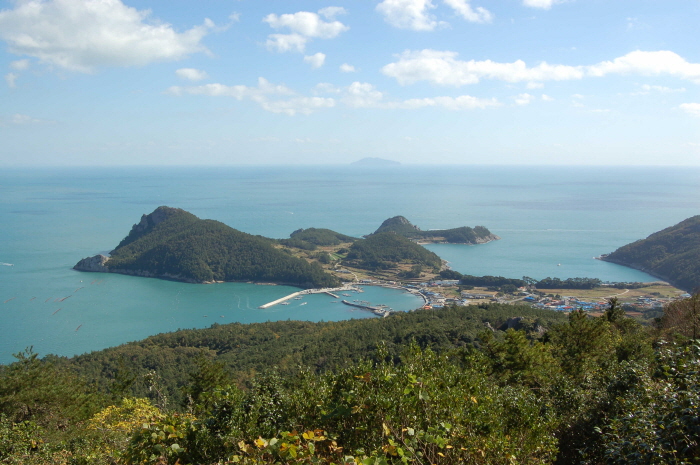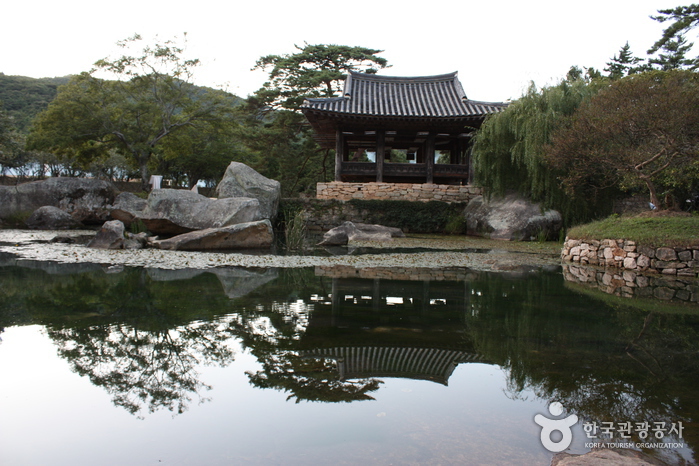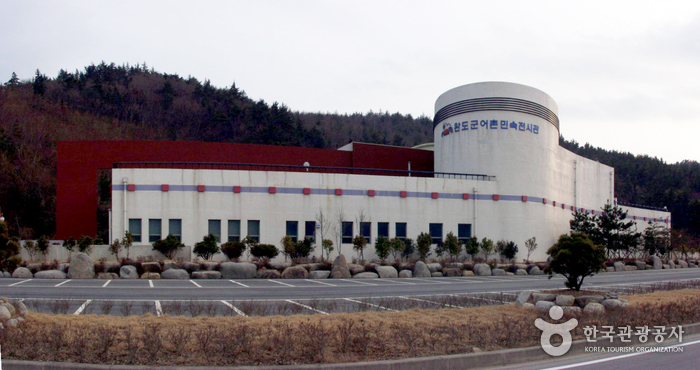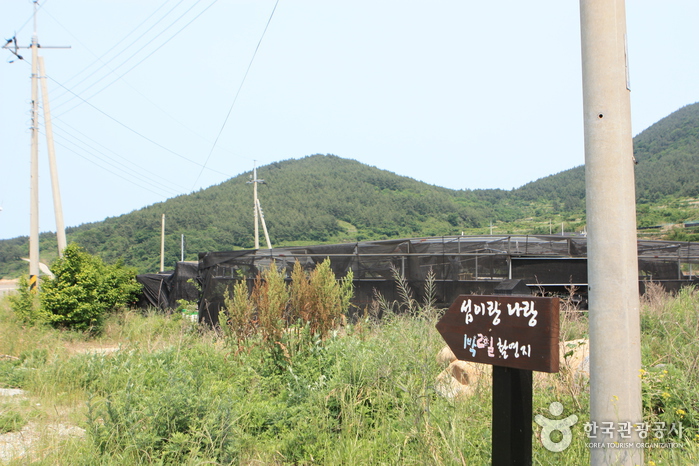Soando Island (소안도)
.0M 2021-11-12
Soan-myeon, Wando-gun, Jeollanam-do
+82-61-550-5609
Soando Island was settled by the Oh Family of Dongbok and the Kim Family of Gimhae, who moved to the island during the Imjin War. It was a very patriotic island during the Japanese occupation, stated to have flown the Korean flag all-year round. Patriots like Song Nae-ho, who fought hard for Korean independence, are remembered on the island at Soan Independence Movement Hall.
In addition, Mira-ri and Maengseong-ri Evergreen Forests, which have been designated as Natural Monuments No. 339 and No. 400 respectively, offer a breathtaking ocean view. Mira-ri Evergreen Forest, in particular, is famous for its unique mudflat pebbles. The waters around the island are also popular among fishermen nationwide.
Jungni Beach (중리해수욕장)
5.2Km 2021-07-14
Jungtong-ri, Wando-gun, Jeollanam-do
+82-61-550-6625
Jungni Beach is the best beach for swimming in the sea on Bogildo Island. The white sandy beach is long and the depth of the water is shallow enough for people to enjoy, even at 200 meters into the water. The beach is also lined with pine trees that provide shade from the hot sun. The road to the beach is also paved, making it easy to reach.
Within a little distance from Jungni Beach there is a small and beautiful beach called Tongni Beach. The silver sand is lined with pine trees and the water is shallow. During summer, visitors can access the shower booths, water fountains, and convenience store at Jungni Beach and Tongni Beach. Accommodations and restaurants can be found in the nearby village. Approximately 1.5 kilometers away, there is an evergreen forest (Natural Monument No. 40) and a river with large black rocks stretching 1 kilometer.
Nohwado Island (노화도)
7.1Km 2022-06-20
813, Nohwa-ro, Wando-gun, Jeollanam-do
+82-61-550-5152
Nohwado Island, a stopping point en route to Bogildo Island, is well known for its abalone and mussel production. The island produces 70% of Korea's cultivated abalone, and offers seashell harvesting programs. Other attractions include Nohwa Red Sea, Geuknaksa Temple, and the 450-year-old hackberry tree.
Bogildo Island Seyeonjeong Pavilion (보길도 세연정)
8.3Km 2021-12-23
57, Buhwang-gil, Wando-gun, Jeollanam-do
+82-61-550-5761
Yun Seon-do (1587~1671), a non-military civil administrator and poet in the mid Joseon dynasty, could hardly contain his anger after hearing the news that the king had surrendered during the Byeongjahoran War (Chinese invasion of Korea in 1636). Following the events, he decided to live in seclusion by moving to Jeju Island. However, on the way to Jeju, he came across Bogildo Island and he was so inspired by its beauty that he ended up settling down on Bogildo instead.
For the following 13 years, he composed great poems such as "Eobusasisa (Fisherman's Song for Four Seasons)." Some of the mountain peaks and rocks named by him still remain on the island.
Seyeonjeong Pavilion was built by Yun Seondo and this is the birthplace of his literary works. On clear days, he would come to the pavilion with his family and let singers sing his verses.
Bogildo Island embraces both the Eastern outlook on nature and Neo-Confucianism ideology. While going around the island, visitors will get some semblance of how Yun Seondo harmonized man and nature through the combination of the island's natural and the man-made features.
Bogildo Island (보길도)
11.0Km 2021-09-04
Bogil-myeon, Wando-gun, Jeollanam-do
+82-61-550-5152
Located about 12 kilometers away from Wando Port, Bogildo Island was once inhabited by a famous Joseon poet named Yun Seon-do, who found the island by chance when he sought shelter from a typhoon he encountered on his way to Jeju Island. During his 10-year stay on the island, he built 25 buildings, including Seyeonjeong and Nakseonjae Pavilions. His most noted work "Eobusasisa" was also written here.
The island has three beautiful beaches, serving as a popular vacation destination. The southernmost Yesong-ri Beach is especially popular for its astounding views with a 1.4-kilometer stretch of pebbled shore with an evergreen forest nearby.
Dadohaehaesang National Park (Wando Section) (다도해해상국립공원(완도))
12.9Km 2024-04-04
Wando-eup, Wando-gun, Jeollanam-do
+82-61-550-0900
Dadohaehaesang National Park was established on December 23, 1981 as the 14th national park, and it is the nation's largest park, spread over 2,344 ㎢. Within this area are nearly 1,700 islands of varying sizes, including Hongdo, Heuksando, Geomundo, and Baekdo Islands. During the Silla period, the King of the Sea, Jang Bogo established the maritime world and during the Goryeo dynasty, the area was a trading path with the Yuan and Song dynasties. Also, it was the battlefield where Admiral Yi Sun-sin defeated the invading navy during the Imjin War (1592-1598). Likewise, historical sites remain in many places.
Wando Jeongdo-ri Gugyedeung Pebble Beach (완도 정도리 구계등)
17.5Km 2024-02-20
152-1 Jeongdo-ri, Wando-eup, Wando-gun, Jeollanam-do
Gugyedeung Pebble Beach is the area near in Wando Port. The rounded pebbles, such as those found at Gugyedeung Pebble Beach, Jeongdo-ri, have been smoothed and rounded by waves over tens of thousands of years. The unique sound of waves crashing against the pebbles is like a song, and the harmony between the sea and forest paths is beautiful, attracting many travelers.
Wando Fishery and Folklore Museum (완도어촌민속전시관)
17.9Km 2022-08-25
149, Hwaheungpo-gil, Wando-gun, Jeollanam-do
+82-61-550-6911
During the Jangbogo Festival, mariners from the Wando area donated rare animals, plants, fish, and shellfish. The sea animals and plants exhibition event attracted a large number of visitors increasing tourism in the area. In response to the public opinion Wando-gun built an exhibition hall to provide tourism and marine folklore education.
Wando-gun, Cheongsando Island [Slow City] (완도군 청산도 [슬로시티])
18.9Km 2020-06-11
19-3, Docheong 4-gil, Wando-gun, Jeollanam-do
+82-61-550-5151
The name Cheongsan (靑山) carries the meaning that all of the surroundings - the mountains, ocean and sky - are blue. Cheongsando Island is a small island featuring beautiful scenery located 19.2km from Wando in Jeollanam-do, and is the southernmost island in Dadohae. The island looks to Geomundo Island in the east, Soando Island in the west, Jejudo Island in the south, and Sinjido Island in the north. Cheongsando Island was designated as part of Dadohaehaesang National Park on December 23, 1981 and the first Asian slow city on December 1, 2007. The slower visitors walk through the island, the more beautiful the island is. Likewise, the island was picked as one of must-visit tourism spots by Korea Tourism Organization and CNN. The island also features the valuable agricultural asset of gudeuljangnon, terraced rice paddies.
Cheongsando Slow Walking Festival (청산도 슬로걷기축제)
19.1Km 2024-11-29
Cheongsan-myeon, Wando-gun, Jeollanam-do
• 1330 Travel Hotline: +82-2-1330 (Korean, English, Japanese, Chinese) • For more info: +82-61-550-5432
Designated as the first Slow City in Asia, Cheongsando in Wando-gun hosts the annual Cheongsando Slow Walking Festival. The festival is held every April, which is the best time of the year to enjoy the canola blossoms and barley with the sea in the background. During the festival, visitors can participate in various cultural events and exhibitions, and enjoy the spring scenery.




![Wando-gun, Cheongsando Island [Slow City] (완도군 청산도 [슬로시티])](http://tong.visitkorea.or.kr/cms/resource/42/1784242_image2_1.jpg)

 English
English
 한국어
한국어 日本語
日本語 中文(简体)
中文(简体) Deutsch
Deutsch Français
Français Español
Español Русский
Русский